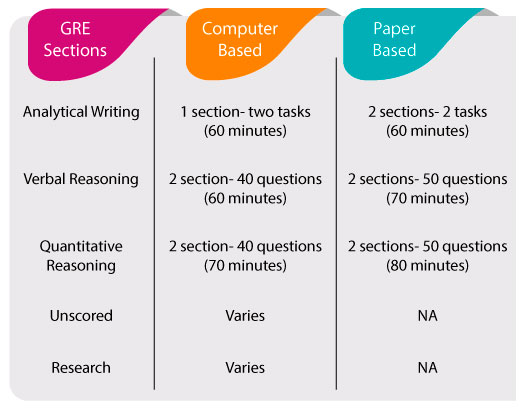What is GRE?
The Graduate Record Examinations (GRE) is a standardized test that is an admissions requirement for many graduate schools in the United States and Canada.
According to ETS, the GRE aims to measure verbal reasoning, quantitative reasoning, analytical writing, and critical thinking skills that have been acquired over a long period of learning.

Sections :
Verbal Section :
The computer-based verbal sections assess reading comprehension, critical reasoning, and vocabulary usage. The verbal test is scored on a scale of 130–170, in 1-point increments. In a typical examination, each verbal section consists of 20 questions to be completed in 30 minutes. Each verbal section consists of about 6 text completion, 4 sentence equivalence, and 10 critical reading questions.
Quantitative Section :
The computer-based quantitative sections assess basic high school level mathematical knowledge and reasoning skills. The quantitative test is scored on a scale of 130–170, in 1-point increments.
In a typical examination, each quantitative section consists of 20 questions to be completed in 35 minutes. Each quantitative section consists of about 8 quantitative comparisons, 9 problem solving items, and 3 data interpretation questions.
Analytical Writing Section :
The analytical writing section consists of two different essays, an “issue task” and an “argument task”. The writing section is graded on a scale of 0–6, in half-point increments.
The essays are written on a computer using a word processing program specifically designed by ETS. The program allows only basic computer functions and does not contain a spell-checker or other advanced features.
Each essay is scored by at least two readers on a six-point holist scale. If the two scores are within one point, the average of the scores is taken. If the two scores differ by more than a point, a third reader examines the response.
Issue Task
The test taker is given 30 minutes to write an essay about a selected topic. Issue topics are selected from a pool of questions, which the GRE Program has published in its entirety.
Argument Task
The test taker will be given an argument (i.e. a series of facts and considerations leading to a conclusion) and asked to write an essay that critiques the argument. Test takers are asked to consider the argument’s logic and to make suggestions about how to improve the logic of the argument.
Test takers are expected to address the logical flaws of the argument and not provide a personal opinion on the subject. The time allotted for this essay is 30 minutes. The Arguments are selected from a pool of topics, which the GRE Program has published in its entirety.
Experimental section
In addition, you will see one of the following sections:
- Unscored (may be either Verbal Reasoning or Quantitative Reasoning)
- Research (used for ETS research purposes)
GRE Scoring System :
The GRE is a Multi-Stage Test, which means that your performance on the first section of the scored Verbal and Quant sections will determine the level of difficulty of the subsequent Verbal and Quant sections.
The raw score from each section is the number of questions you answered correctly. Your raw score is then converted to a scaled score through a process called “equating.”
For example, if you perform very well on the first Verbal section, you will receive the most difficult second section in Verbal, but you’ll also have access to the highest potential score range.
If you perform less well on the first section of Verbal, you’ll see a less difficult second Verbal section, but you’ll also have access to a lower score band or “potential.”
For the Analytical Writing section, each essay receives a score from at least one human reader, using a 6-point scale.
